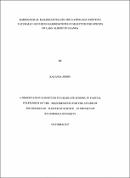Radiological hazard levels by the gamma ray emitting naturally occurring radioisotopes in selected fish species of Lake Albert in Uganda
Abstract
A study was conducted for natural radioactivity in some fish samples from Lake Albert,
shared by five riparian districts namely Ntoroko, Kibaale, Hoima, Buliisa and Nebbi, located
in the western part of the great rift-valley. Radioactivity is a phenomenon that leads to
production of ionizing radiations and these are known to trigger or induce cancer. The fish
were analyzed to estimate the radioactivity (activity) concentrations due to natural
radionuclides Thorium (232Th), Radium (226Ra) and Potassium (4°K).
The Gamma ray spectrometry technique was used in the spectral collection and analysis of the
prepared fish samples using the Thallium activated Sodium iodide scintillator (Nal (TI)),
GDM 20. The detector produced readings of Standard Deviation (S .D), Full Width at Half
maximum (FWHM) in keV, Rate(R), number of radionuclides (n) in each peak interacting
with the crystal and live time (t) in seconds from which the raw data was obtained for the
computation of the Activity concentrations, Dose Rates, Annual Effective Dose and
Radiological Hazard Indices due to 232Th, 226Ra and 4°K in fish samples using mat lap
program and Microsoft excel 20 I 0 (spread sheet)
The result of this study showed that the act1v1ty concentrations of 232Th ranged from
3.27±0.29Bqkg· 1 to 7.64±0.46Bqkg"1 with an average concentration of 5. I 6±0.37Bq/kg, 226Ra
ranged from 27.22±2.13Bqkg"1 to 41.75±2.69Bqkg·1 with a mean of 33.10±2.41 Bqkg-1 and 4°K
ranged from 392.52±11.07Bqkg-1 to 465.64±13.0IBqkg-1 with a mean value of
435.16± 12.0 !Bqkg-1.According to the results obtained in this study, mean activity
concentrations of the radionuclides increased according to the order 232Th < 226Ra < 4°K and
these were lower than the worldwide maximum permissible values of 50, 50 and 48 1 Bqkg·'
respectively for 232Th, 226Ra and 4°K in fish.
The absorbed dose rate for 232Th in all the species analyzed ranged from I .593nGyh·1 to
3.495nGyh· ' with the average value of 2.485nGyh-1
. For the dose rate due to 226Ra
radioisotope in the fish species ranged from 15 . l 85nGyh·1 to 2 I .73?nGyh with the average
value of I 8.454nGyh-1. Also the dose rate due to 4°K radioisotope in the species ranged from
16.368nGyh·' to I 9.335nGyh·1 with the average value of I 8.149nGyh-1
All of these values

